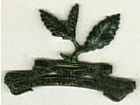- Ceylon Planters Rifle Corps
-
Ceylon Planters Rifle Corps 
Cap badge of the Ceylon Planters Rifle CorpsActive 1900-1949 Country Ceylon Branch Ceylon Defence Force Type Militia Role Infantry Part of British Army Garrison/HQ Kandy Nickname CPRC Motto Unitas Sales Nostra Engagements Second Boer War
World War I
World War IICeylon Planters Rifle Corps was a regiment attached to the Ceylon Defence Force which was the predecessor to the Sri Lanka Army prior to 1949 when the Ceylon Army was formed. It was a volunteer (reserve) regiment based in Kandy, made up of only Europeans, who were tea and rubber planters of the hills of Sri Lanka.
Contents
History
After the disbandment of the Ceylon Rifle Regiment (CRR) in 1873 the only locally raised regular outfit some British planters and mercantile elite want to had before this had tried to create a volunteer infantry unit loosely known as the Matale Rifle Volunteer Corps but only months after its creation it was decommissioned.
In 1900 a new regiment named the Ceylon Planters Rifle Corps was established with headquarters in Kandy; the officers and other ranks were made up of Europeans, who were tea and rubber planters in the central highlands of Ceylon. Its first Commanding Officer was Colonel R.N. Farquharson, a retired Naval Captain. The regiment was a volunteer regiment mobilized under internal emergencies or for deployments overseas.
The regiment's first deployment was on February 1st 1900 when a first detachment was sent to South Africa under the command of Major Murray-Menzies and saw action in Cape Colony, Drifontein, Johannesberg, Diamond Hill and Wittebergen, earning the Queen’s and the King’s Medals with 7 clasps. The CMI lost 1 officer (Lt. A.H. Thomas, killed in action) and 7 other ranks during this campaign. A 2nd. detachment was sent to South Africa in 1902 arriving just before hostilities ended, not having experienced combat in the Second Boer War. The overall conduct of Ceylon troops received accolades from General Kitchener, Chief of Staff to Lord Roberts in South Africa, who affirmed, “The Ceylon Contingent did very good work in South Africa I only wish we had more of them.”
In the First World War the regiment sent a force of 8 officers and 229 other ranks commanded by Major J. Hall Brown. The unit sailed for Egypt on October 1914, and was deployed in defence of the Suez Canal. After which the unit was transferred to the Australia New Zealand Army Corps (ANZAC) and was in 1915 dispatched to Anzac Cove (‘Z’ Beach) on the Gallipoli Peninsula. The CPRC also performed operational duties as guards to ANZAC headquarter staff, including the General Officer Commanding ANZAC, Lieutenant General William Birdwood, who remarked, “I have an excellent guard of Ceylon Planters who are such a nice lot of fellows.” According to its onetime Commanding Officer (CO), Colonel T.Y. Wright (1904–1912), the CPRC had sustained overall losses of 80 killed and 99 wounded in the First World War.
The CPRC was once mobilized once more when World War II started in 1939. Although primarily deployed for home defence in Ceylon the CPRC source for officer reinforcements, providing an estimated 700 volunteers to be commissioned as officers in the British Army and British Indian Army. Between August 1940 and July 1942, the CPRC dispatched six contingents amounting to 172 soldiers as officer reinforcements to the Officer Training School at Belgaum, India.[1]
With Ceylon gaining independence from Britain the Ceylon Planters Rifle Corps was disbanded on 11 April 1949 along with the Ceylon Defence Force which led to the formation of the Ceylon Army.
Recent years
In 1984 on request of planters in the highlands, the Sri Lanka Rifle Corps was created, based on the Ceylon Planters Rifle Corps . The two battalions were raised in Pallekele and Neuchatel Estate Neboda. The Rifle Corps has since then been deployed both in the central highlands and other parts of Sri Lanka due to the current civil war, with its members coming from the highlands and the plantations.
See also
- Ceylon Defence Force
- Sri Lanka Rifle Corps
- Sri Lanka Army
- Australian and New Zealand Army Corps (army corps)
References
External links and sources
- cap badge, collar badges, shoulder titles, large and small button
- Sri Lanka Army
- Sri Lanka Riffle Corps
- [1]
- [2]
- Ceylon Defence Force
- [3]
- regiments.org
- regiments.org
- [4]
Regiments and corps of the Sri Lanka Army Combat Arms Armoured Corps · Light Infantry · Sinha Regiment · Gemunu Watch · Gajaba Regiment · Vijayabahu Regiment · Mechanized Infantry · President's Guard · Commandos · Special Forces · Rifle Corps · National GuardSupport Arms Support Services Disbanded Ceylon Mounted Rifles · Ceylon Planters Rifle · Ceylon Railway Engineer · Ceylon Rifle · Colombo Town Guard · National Service Regiment · Post and Telegraph Signals · Rajarata Rifles · Ruhunu RegimentCategories:- Regiments of Ceylon
- British colonial regiments
- Military units and formations established in 1900
- Military of Ceylon under British rule
- Military units and formations disestablished in 1949
Wikimedia Foundation. 2010.
